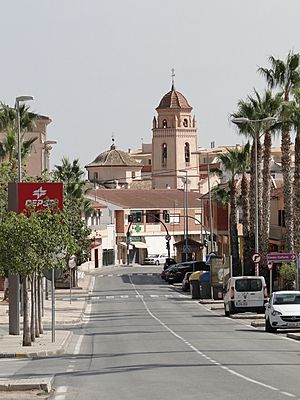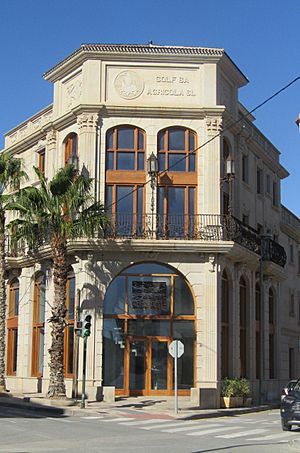Sucina facts for kids
Sucina is a small village in southeastern Spain. It's part of the municipality of Murcia in the Region of Murcia. Sucina is about 29 kilometers (18 miles) from the city of Murcia and 15 kilometers (9 miles) northwest of San Javier. In 2019, about 2,098 people lived there.
Contents
What You Can Find in Sucina
The heart of Sucina has a church called 'Nuestra Señora del Rosario'. It was fixed up because it was very old. Next to the church, you'll find a bank and a restaurant. <mapframe latitude="37.892094" longitude="-0.952892" zoom="13" width="441" height="291" align="right" /> Two roads go up from the church, lined with small, old houses from the 1700s. The local bakery, known as the 'Panaderia', is also there. They make Pasteles (cakes), which are a big part of Spanish celebrations like birthdays and holidays. New homes and holiday resorts are also being built in the area.
Sucina has two town halls, called Ayuntamientos. The older one is in the historic part of town. Inside, there's a small theater and a hairdresser. You can also get information about local activities and events there. Outside, there's a playground for children. Older people often sit on benches under the trees, watching the children play. There's also a small stage outside for outdoor events.
A bit further away, at the edge of town, is the newer town hall. It looks much more modern. Nearby, you'll find a petrol station and a tobacconist. There's also a small shop (kiosk) that sells snacks like crisps, salted popcorn, and sunflower seeds.
A Look at Sucina's History
Around the 1500s or 1600s, more people started living in the countryside around Murcia. Sucina was first known as 'El Pozo de Sucina', which means 'Sucina's Well'. It was also called 'Cañada de Sucina', meaning 'Sucina's canyons'.
For a short time, between 1820 and 1823, Sucina became its own independent town. This meant it had its own local government and included nearby areas like Balsicas and Gea and Truyols. However, in 1823, it went back to being part of the Murcia City Council.
In the early 1700s, when farming was very important in Murcia, Sucina was a dependent town. A local parish (a church area with its own priest) was set up in Sucina in 1744. In 1768, records show that 919 people belonged to this parish. In the early 1800s, the town hall (Ayuntamiento) was built. Around this time, many houses were built for the workers in the town, including 50 terraced houses and 400 semi-detached homes.
Sucina's Geography
The land in Sucina is quite dry because there isn't a river or lake nearby. So, the main source of water comes from rain.
Sucina shares its borders with:
- Northwest: Cañadas de San Pedro
- Northeast: The municipality of Orihuela
- West: Gea and Truyols
- Southwest: Jerónimo and Avileses
- South: The municipality of San Javier
How Sucina Makes Money
Farmers in Sucina grow many different crops for export. These include almonds, olives, wheat, artichokes, green beans, melons, lemons, and tomatoes. Growing these products is the main farming activity. The biggest business in Sucina is growing, transporting, and selling almonds. You can also find wildlife like birds and rabbits living in these areas.
Population Changes
In the 1900s, Sucina saw big changes in its population. In 1960, there were 1,714 people living there. This number went down to 1,005 by 1970 and then to 985 in 1991. However, by 1996, the population started to grow again, reaching 1,054 people.
Gallery
See also
 In Spanish: Sucina para niños
In Spanish: Sucina para niños



